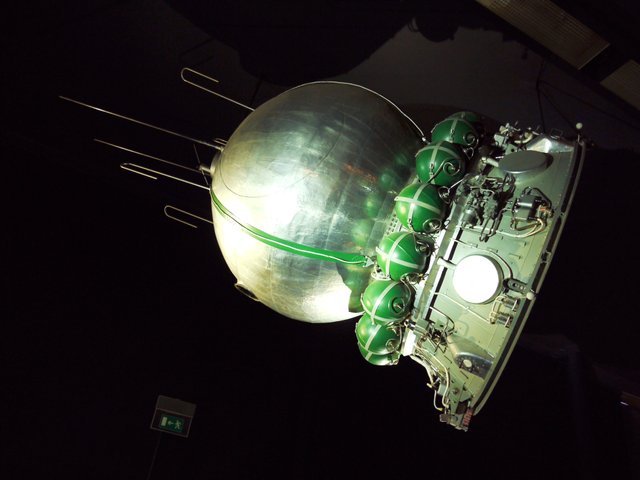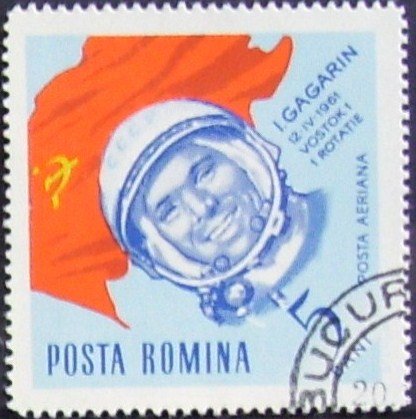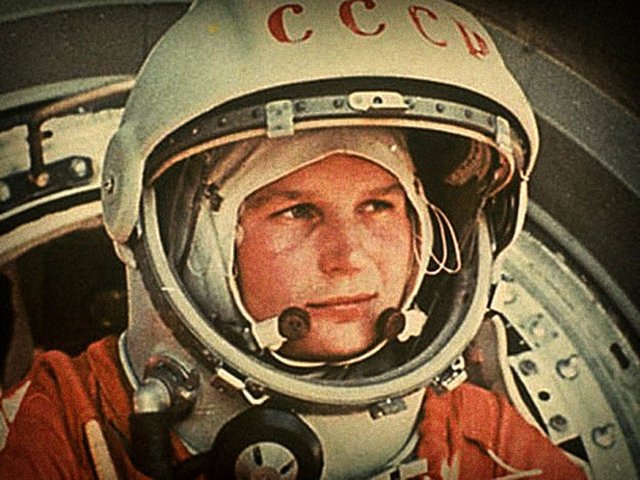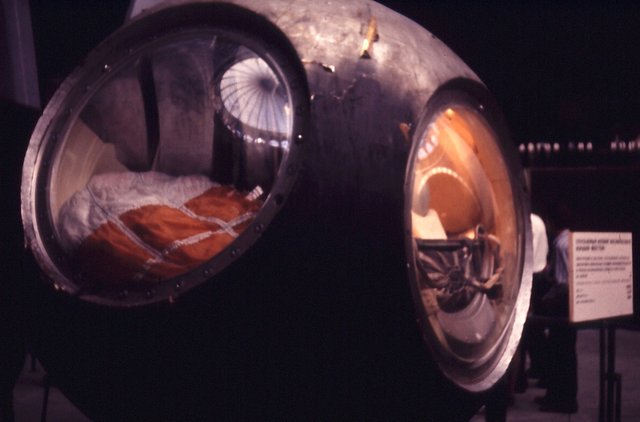The story of the first man who traveled to outer space - Yuri Gagarin
Important character :
Yuri Gagarin
Yuri Alekséyevich Gagarin (Russian: Юрий Алексеевич Гагарин; Klúshino, Soviet Union, March 9, 1934-Novosyolovo, Soviet Union, March 27, 1968) was a Soviet cosmonaut, known to be the first human being to travel to outer space .
Gagarin was a Soviet military pilot who actively participated in the space program developed in the USSR. On April 12, 1961, on board ship Vostok 1, he was launched into outer space, being the first human being to reach it and travel through it. He holds the awards of Hero of the Soviet Union and Hero of Socialist Labor among others.
Yuri Gagarin (1934-968)
Childhood and youth
Yura was born in the small town of Klúshino, near Gzhatsk, in the province of Smolensk, on March 9, 1934. Gzhatsk was renamed Gagarin in his honor in 1968. His parents, Alexey Ivanovich Gagarin and Anna Timofeyevna Gagarina, worked in a collective farm. Gagarin was born into a humble family of the so-called "simple peasants." His mother was an avid book reader and his father a talented carpenter. Yuri Gagarin was the third of four brothers and her older sister was the one in charge of taking care of her while her parents worked.
During the Second World War, the village where Gagarin's family lived was occupied by German troops and his house was requisitioned by the Nazi army to serve as a home for a German officer. Gagarin's family built a small mud hut where they hid a year and nine months until the end of the foreign occupation.Their two older brothers were deported to Nazi Germany as slave labor in 1943, and did not return until after from the war. In 1946, the family moved to Gzhatsk.
Yuri was a worker in the metallurgical industry until 1954, when he signed up at the air club in the city of Saratov. He learned to fly a light aircraft, a hobby that became more and more intense. Apparently he was a great follower of Russian rugby, and for that reason he later wanted the recruits of the Gagarin Academy to practice the sport of the oval ball.
Elena Gagarina, daughter of Yuri Gagarin, affirms that the vocation of pilot arose to him to Yuri during World War II, when a Soviet airplane was demolished on its town and Gagarin along with another companion rescued to the pilot and they kept hidden from the Nazis until Another friend came to look for him in another plane. Also the influence of a math teacher who fought with the Red Army of the Air during the Great Patriotic War, was a fact that impressed the young Gagarin.

Museum and birthplace of Gagarin, Klúshino. (2008)
His career in the Soviet space program
In 1955, after finishing his technical studies, he entered the Military School of Pilots of Orenburg. During his stay at the school he met Valentina Goriácheva, with whom he married in 1957, after getting his pilot wings. In the same year, the Soviet Government made major milestones in space exploration, ahead of the United States by putting into orbit the first artificial satellite, Sputnik 1, on October 4, and November 3, putting into orbit the Sputnik 2 with Laika , the first living being in space. Shortly after, in 1959, Yuri is presented as a candidate for the risky space program of the Soviet Government.
Habitable module of Vostok 1 (RKK Energiya museum)
Selection and training
In 1960, the Soviet space program opened a selection process which was attended by some 3,500 volunteers, 5 all fighter pilots. The twenty selected received initial training and then a group of six men was chosen. Finally Gagarin is chosen as the first cosmonaut, and is subjected to a series of experiments and tests to determine their physical and psychological resistance during the flight.
Gagarin competed in this selection with German Titov and Grigori Nelyubov. Gagarin got better grades and also had in his favor with better physical characteristics: it measured 1.57 m (5 ft 2 in) meters high, an advantage in the small cabin of the ship Vostok.3 Titov in the first flight into space He remained as a reserve in case Gagarin failed, whom he accompanied, also dressed in the cosmonaut suit, to the rocket. Three months later, Titov became the second Soviet pilot to fly into space, after the American Alan Shepard.
Minutes before boarding his ship he recorded a message:
Dear friends, acquaintances and strangers, my dear compatriots and all the people of the world.
In the next few minutes a powerful spacecraft will take me to the distant spaces of the universe.
What can I tell you during these last minutes before you start? All my life now seems to me a unique and beautiful moment.
Everything I have done and lived has been done and lived for this moment.
Space flight
On Wednesday, April 12, 1961, Gagarin became the first human being to travel to space on the ship Vostok 3KA-3, better known as Vostok 1. His code name during the flight was Kedr (in Russian кедр, cedar), that is, Siberian pine, the land operators were Zaryá (Заря, Aurora) and Vesna (Весна, spring) .7 It is known that the flight lasted 108 minutes in total: 9 minutes to enter orbit and then an orbit around The Earth.5 Meanwhile, all he had to do was talk on the radio, try some food-he was the first to eat on board a spaceship-in order to know if a human being could feel and behave normal way being without gravity.
The scientists did not know with certainty the effects of weightlessness, and the ship was always under ground control. In case of emergency, it had all the necessary flight instruments for manual landing. Gagarin was attached to an ejection seat, by means of which he would leave the ship's module after the descent, at an altitude of approximately 7 kilometers.
The Vostok 1 flight started at 06:07 UT, powered by a Vostok-K rocket from the Baikonur Cosmodrome. The ground controllers did not know if Gagarin had reached a stable orbit until 25 minutes after launch, just as it was heading towards the unlit side of the Earth and leaving the Soviet Union behind across the Pacific Ocean. He crossed the Strait of Magellan at dawn and during the dawn the vast South Atlantic Ocean. Then the ship's automatic system was activated to align the capsule and fire the recoil rockets to begin the descent, while crossing the western coast of Angola, some 8,000 kilometers away from the landing point.

Model of Vostok 1 (Museum of Air and Space, in France).
During this critical point of atmospheric reentry, the most serious problem of the flight was presented. The ship had to detach itself from a part if it wanted to reentry successfully by adopting an appropriate orientation or it would end up turned into a great ball of fire. For 10 uncomfortable minutes, and without being able to act, the capsule turned violently. The automatic release system had failed and Gagarin's life was in danger. Luckily, with the immense heat generated during the reentry the anchoring system was weakened and the capsule was released with Gagarin inside. While its descent continued, it crossed the dark forests and mountains of central Africa, then the Sahara, the Nile River, the Middle East, while continuing its descent towards the south-west of the present Russian Federation. Prepared to start the expulsion and already close to the Black Sea, he gets rid of the capsule at 7000 meters above the ground.
Due to an error of the braking system, it did not land in the planned region (about 110 kilometers from Stalingrad, today Volgograd), but in the province of Saratov. At 10:20 that day, Gagarin, after being fired from the Vostok capsule, landed by parachute near the town of Smelovka, about 15 kilometers from the city of Engels. Peasant Anna Tajtárova from a nearby collective farm and her six-year-old granddaughter Rita were the first people to find Gagarin. He wore a strange orange suit and a white helmet with big initials in red, CCCP (the acronym in Russian of the Union of Soviet Socialist Republics). "Are you coming from space?" The old woman asked. "Certainly, yes," said the cosmonaut who, in order to calm the peasant woman, hastened to add: "But do not be alarmed, I am Soviet." The first immediate measure of the Soviet government is its rise from the military rank of second to older lieutenant.
According to the Soviet media, during the orbit Gagarin commented: "Here I do not see any God." However, there is no recording to show that Gagarin uttered those words, whereas Nikita Khrushchev is known to have once said: "Gagarin was in space, but he saw no God there." Then these words began to be attributed to the cosmonaut What the cosmonaut did say with certainty from the ship Vostok 1 was: "Settlers of the world, safeguard this beauty, do not destroy it". In addition, Petrov said that Gagarin was baptized as a child in an Orthodox church, and in 2011 an article in the Foma magazine quotes the rector of the Orthodox Church in Star City saying that «Gagarin baptized his eldest daughter Elena shortly before her flight into space» and that her family I used to celebrate Christmas and Easter.
Flight instrument panel of Vostok 1 ship.
Subsequent activities
Back on Earth, Gagarin became a famous character. Nikita Khrushchev considered that Gagarin's achievement was proof that the Soviet army should be reinforced with missiles rather than conventional weapons. This policy, antagonistic to the wishes of the Soviet army, contributed to the fall of Khrushchev.
After the flight, Gagarin traveled around the world to promote the Soviet feat. He tried to adapt to fame but he did not succeed.
Gagarin himself, in his book Veo la Tierra, commented on how he changed his life by being the first human to go out into space. It says in the last chapter:
After having fulfilled the space mission it was difficult for me to walk through the streets of Moscow and the Red Square without anyone noticing me and without being recognized. Popularity is an irreparable thing. One is forced to meditate, to whom and to whom is it due?
A foreign correspondent asked me: Does not it annoy you, Gagarin, that celebrity who has won since April 12, 1961? Now, continue. He has guaranteed rest until the last days of his life ...
Rest ?, I replied, here in the Soviet Union, everyone works, and the famous people, Heroes of the Soviet Union and Socialist Labor, do it with as much or greater dedication. There are thousands in the country, and they try to work as well as possible, serving as an example to be imitated by others.
After the first space flights the work did not diminish, on the contrary, it increased. All of us continue studying. We deepened our knowledge regarding cosmic flights. We do not abandon the cosmonaut detachment, we continue working in the classrooms and laboratories, sharing the experiences with the future cosmonauts.
According to some versions, this, together with the problems he had in his marriage and the order of the authorities not to allow him to fly planes, led him to start abusing alcohol.On October 3, 1961 in a sanatorium in Crimea Gagarin seriously wounded, when he jumped drunk on a second floor hiding from his wife, when she caught him trying to seduce a young nurse. The wound was a perforation of the skull and he was about to die, this wound prevented him from attending the XXII Congress of the Communist Party of the Soviet Union, inaugurated on October 17. Gagarin underwent a successful plastic surgery operation to make up the wound on his left eyebrow.18 19 Gagarin's adventures with women worsened relations with his wife.20 21
In 1962 and 1966 he was elected deputy to the Supreme Soviet of the USSR. He was appointed deputy chief of the Cosmonaut Training Center, which remains in the City of Stars and which, since 1968, bears his name. In 1967 he was selected as a reserve cosmonaut for the Soyuz 1 ship. The parachute of the capsule failed during the reentry and Vladimir Komarov perished.
Death
Gagarin died at age 34 on March 27, 1968, when the MiG-15UTI training fighter he was traveling on during a routine flight crashed near Moscow, in Novosyolovo. The real causes of the accident were not published, but in 1986 an investigation suggested that the turbulence caused by another plane could have destabilized Gagarin's ship. The weather conditions that day outside of Moscow were also not favorable. There was also talk that Gagarin's ability to drive because he was drunk could have been affected. A menhir points to the exact point where, at 10:30, the fighter in which the world's first cosmonaut flew and his instructor, Vladimir Seryogin, plummeted, sinking six meters into the ground.
Soviet Colonel Igor Kuznetsov, after studying the case for seven years, with thousands of documents and evidence, came to the conclusion that the accident of Gagarin's MiG-15 would have been the product of a panic attack when he noticed that a pipeline The cabin's ventilation was open, which caused the plane to plummet, causing it to fade and then crash into the ground.
However, on June 15, 2013 ex-demographer Alekséi Leónov made a statement on Russian state television RT stating that, according to a declassified government report, Gagarin's death happened because of human error. This error was that a Sukhoi Su-15 destined for a test flight in Novosyolovo on the same March 27, 1968 generated a supersonic shock wave to rise only 500 meters from the ground (and not to 10,000 meters, as planned ) and passed too close to the MiG-15 apparatus where Gagarin and Seryogin were. The supersonic shockwave of the Su-15 flying at such a low altitude caused Gagarin and Seryogin to lose control of their MiG-15 and crash. During his statement Leonov indicated that he would not mention the name of the Su-15 pilot, saying only that "he is now 80 years old and in poor health" and that identifying that individual "would not fix anything".
Gagarin and his co-pilot Seryogin were buried with state honors and recognition as Heroes in the Necropolis of the Moscow Kremlin Wall on March 30, 1968. At that time it was speculated in the Western Bloc countries that the accident that ended with their lives it was possible to produce during the tests of an airplane capable of flying more than 40 km high.

Postage stamp in honor of Gagarin's trip
bibliographic references
1 . Yura (Юра) is the diminutive of his name Yuri (Юрий)
2 . Hanbury-Tenison, Robin, ed. (2010). The Great Explorers. London: Thames & Hudson. p. 270.
3 . Jump to: a b Tito, Dennis (November 13, 2006). "Yuri gagarin". Time Europe via Time.com. Retrieved on March 30, 2008.
4 . Moskvitch, Katia (April 3, 2011). «Yuri Gagarin's Klushino: Forgotten home of space legend». BBC News Accessed on April 4, 2011.
5 . Jump to: a b c «Gagarin, pioneer in orbit». Euronews. April 11, 2011. Retrieved on April 16, 2011.
6 . The original audio of Gagarin's message can be heard during the first minute of the documentary First Orbit.
7 . Юрий Гагарин. Дорога в космос - Gagarin's book Path to the Cosmos (in Russian) (HTML)
8 . English, Dave (2003). The air up there: more great quotations on flight (in English) (1 edition). USA: McGraw-Hill Professional. p. 118. ISBN 9780071410366. "First words upon returning to earth, to a woman and a girl near where his capsule landed (12 April 1961) The woman asked:" Can it be that you have come from outer space? " to which Gagarin replied: "As a matter of fact, I have!" ».
9 . In Spain, rank equivalent to that of commander.
10 . Recording of Gagarin's conversations with Earth. (in Russian)
11 . Interview with a close friend of Gagarin. (in Russian)
12 . Lev Aleksandrovich Lebedev, Boris Borisovich Luk'i︠a︡nov, Aleksandr Romanov (1973). Sons of the blue planet (in English) (1 edition). USA: Amerind Pub. Co. p. 327. «Orbiting Earth in the spaceship, I saw how beautiful our planet is. People, let us preserve and increase this beauty, not destroy it! »

